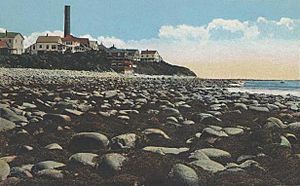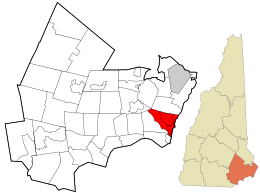Hampton, New Hampshire facts for kids
Quick facts for kids
Hampton, New Hampshire
|
|||
|---|---|---|---|

Great Boar's Head c. 1920
|
|||
|
|||

Location in Rockingham County and the state of New Hampshire.
|
|||
| Country | United States | ||
| State | New Hampshire | ||
| County | Rockingham | ||
| Founded | October 14, 1638 | ||
| Incorporated | May 22, 1639 | ||
| Villages |
|
||
| Area | |||
| • Total | 14.6 sq mi (37.9 km2) | ||
| • Land | 12.9 sq mi (33.4 km2) | ||
| • Water | 1.7 sq mi (4.5 km2) 11.76% | ||
| Elevation | 36 ft (11 m) | ||
| Population
(2020)
|
|||
| • Total | 16,214 | ||
| • Density | 1,256/sq mi (484.9/km2) | ||
| Time zone | UTC-5 (Eastern) | ||
| • Summer (DST) | UTC-4 (Eastern) | ||
| ZIP codes |
03842–03843
|
||
| Area code(s) | 603 | ||
| FIPS code | 33-33060 | ||
| GNIS feature ID | 0873616 | ||
Hampton is a town located in Rockingham County, New Hampshire, United States. In 2020, about 16,214 people lived there. Hampton is on the Atlantic coast. It is famous for Hampton Beach, a popular place for tourists in the summer.
The main part of the town, where most people live, is called the Hampton census-designated place (CDP). This area is centered around the crossing of U.S. 1 and NH 27.
Contents
Hampton's History and Founding
Hampton was first known as the "Plantation of Winnacunnet." It was one of the first four towns in New Hampshire. These towns were given permission to form by the General Court of Massachusetts. This court was like the government for the colony at that time.
The name Winnacunnet comes from the Abenaki language, an Algonquian language. It means "pleasant pines." Today, the town's high school, Winnacunnet High School, is named after this word. This school serves students from Hampton and nearby towns like Seabrook, North Hampton, and Hampton Falls.
In March 1635, Richard Dummer and John Spencer explored the area. They were very impressed by the location. Dummer, who was part of the General Court, helped the court claim the land. They planned to start a settlement there. The Massachusetts General Court ordered them to build a "Bound house" in March 1636.
The town was settled in 1638 by a group led by Reverend Stephen Bachiler. He was a graduate of Oxford University. He had preached in Hampton, England, which is where the new town got its name. Hampton officially became a town in 1639.
Over time, Hampton's original area was much larger. It once included areas that are now Seabrook, Kensington, Danville, Kingston, East Kingston, Sandown, North Hampton, and Hampton Falls.
In 1679, King Charles II appointed Christopher Hussey to help govern the new province of New Hampshire. Hussey was Stephen Bachiler's son-in-law.
Thomas Leavitt was another early settler of Hampton. His family played an important role in the town's history. Later, members of the Leavitt family ran Leavitts' Hampton Beach Hotel. This hotel was a well-known place in the area for many years.
In the 1850s, the construction of the railroad and the Exeter and Hampton Trolley line made Hampton's oceanfront a popular vacation spot. Today, Hampton Beach is still a major tourist destination. It offers many shops, restaurants, and beaches for visitors to enjoy.
Hampton's Geography and Location
Hampton covers a total area of about 37.9 square kilometers (14.6 square miles). About 33.4 square kilometers (12.9 square miles) of this is land. The remaining 4.5 square kilometers (1.7 square miles) is water, which is about 11.76% of the town's total area.
The town is drained by the Hampton and Drakes rivers. All of Hampton is part of the New Hampshire Coastal watershed. The highest point in Hampton is Bride Hill. It is about 46 meters (150 feet) above sea level. This hill is near the town's border with Exeter.
Neighboring Towns
Hampton is next to several other towns:
- North Hampton (to the north)
- Seabrook (to the south)
- Hampton Falls (to the southwest)
- Exeter (to the northwest)
Hampton's Climate
| Climate data for Hampton, New Hampshire | |||||||||||||
|---|---|---|---|---|---|---|---|---|---|---|---|---|---|
| Month | Jan | Feb | Mar | Apr | May | Jun | Jul | Aug | Sep | Oct | Nov | Dec | Year |
| Record high °F (°C) | 61 (16) |
66 (19) |
79 (26) |
91 (33) |
99 (37) |
95 (35) |
101 (38) |
100 (38) |
94 (34) |
87 (31) |
76 (24) |
68 (20) |
101 (38) |
| Mean daily maximum °F (°C) | 31.6 (−0.2) |
33.8 (1.0) |
42.2 (5.7) |
53.6 (12.0) |
65.0 (18.3) |
74.3 (23.5) |
79.8 (26.6) |
77.8 (25.4) |
70.3 (21.3) |
59.7 (15.4) |
48.5 (9.2) |
36.1 (2.3) |
56.1 (13.4) |
| Mean daily minimum °F (°C) | 16.1 (−8.8) |
18.0 (−7.8) |
27.3 (−2.6) |
36.7 (2.6) |
46.7 (8.2) |
55.7 (13.2) |
61.6 (16.4) |
60.0 (15.6) |
52.2 (11.2) |
42.0 (5.6) |
33.8 (1.0) |
21.8 (−5.7) |
39.3 (4.1) |
| Record low °F (°C) | −16 (−27) |
−9 (−23) |
0 (−18) |
17 (−8) |
29 (−2) |
38 (3) |
47 (8) |
40 (4) |
32 (0) |
23 (−5) |
11 (−12) |
−9 (−23) |
−16 (−27) |
| Average precipitation inches (mm) | 3.59 (91) |
3.80 (97) |
5.02 (128) |
4.63 (118) |
4.45 (113) |
4.82 (122) |
3.77 (96) |
4.00 (102) |
4.19 (106) |
5.20 (132) |
4.09 (104) |
5.03 (128) |
52.59 (1,336) |
| Average snowfall inches (cm) | 18.6 (47) |
20.5 (52) |
10.9 (28) |
1.4 (3.6) |
0 (0) |
0 (0) |
0 (0) |
0 (0) |
0 (0) |
0.2 (0.51) |
0.8 (2.0) |
10.2 (26) |
62.6 (159) |
| Source: NOAA | |||||||||||||
| Jan | Feb | Mar | Apr | May | Jun | Jul | Aug | Sep | Oct | Nov | Dec | Year |
|---|---|---|---|---|---|---|---|---|---|---|---|---|
| 41.7 °F (5.4 °C) | 39.0 °F (3.9 °C) | 39.0 °F (3.9 °C) | 42.6 °F (5.9 °C) | 50.2 °F (10.1 °C) | 58.1 °F (14.5 °C) | 65.1 °F (18.4 °C) | 66.4 °F (19.1 °C) | 63.0 °F (17.2 °C) | 56.7 °F (13.7 °C) | 50.0 °F (10.0 °C) | 45.3 °F (7.4 °C) | 51.4 °F (10.8 °C) |
Hampton's Population and People
| Historical population | |||
|---|---|---|---|
| Census | Pop. | %± | |
| 1790 | 853 | — | |
| 1800 | 875 | 2.6% | |
| 1810 | 990 | 13.1% | |
| 1820 | 1,098 | 10.9% | |
| 1830 | 1,102 | 0.4% | |
| 1840 | 1,320 | 19.8% | |
| 1850 | 1,192 | −9.7% | |
| 1860 | 1,230 | 3.2% | |
| 1870 | 1,177 | −4.3% | |
| 1880 | 1,184 | 0.6% | |
| 1890 | 1,330 | 12.3% | |
| 1900 | 1,209 | −9.1% | |
| 1910 | 1,215 | 0.5% | |
| 1920 | 1,251 | 3.0% | |
| 1930 | 1,507 | 20.5% | |
| 1940 | 2,137 | 41.8% | |
| 1950 | 2,847 | 33.2% | |
| 1960 | 5,379 | 88.9% | |
| 1970 | 8,011 | 48.9% | |
| 1980 | 10,493 | 31.0% | |
| 1990 | 12,324 | 17.4% | |
| 2000 | 14,973 | 21.5% | |
| 2010 | 14,976 | 0.0% | |
| 2020 | 16,214 | 8.3% | |
| U.S. Decennial Census | |||
In 2010, there were 14,976 people living in Hampton. There were 6,868 households and 4,079 families. About 96.1% of the people were White. Other groups included African American, Native American, and Asian people. About 1.7% of the population was Hispanic or Latino.
About 17.5% of the people were under 18 years old. About 18.2% were 65 years or older. The average age in Hampton was 47.0 years. For every 100 females, there were about 99.4 males.
From 2011 to 2015, the average yearly income for a household was about $76,836. For families, it was about $98,642. About 5.9% of the population lived below the poverty line.
Education in Hampton
Hampton's elementary and middle schools are part of School Administrative Unit 90. Winnacunnet High School is a regional high school. It serves students from Hampton and several nearby communities. This high school is part of SAU 21.
Hampton's Economy
Hampton is home to the main office of Planet Fitness. This is a well-known fitness company.
Places to Visit in Hampton
Hampton has several interesting places to see:
- Benjamin James House (built in 1723)
- Hampton Beach State Park
- Hampton Beach Casino Ballroom
Notable People from Hampton
Many interesting people have connections to Hampton:
- Bill Alfonso (born 1957), a professional wrestling personality.
- Stephen Bachiler (1561–1656), an English clergyman and the town's founder.
- Eunice "Goody" Cole (c. 1590–1680), the only woman ever found guilty of witchcraft in New Hampshire.
- Henry Dearborn (1751–1829), a doctor, general, and the 5th U.S. Secretary of War.
- Abraham Drake (1715–1781), a general during the Revolutionary War and a politician.
- Jimmy Dunn, a stand-up comedian and actor.
- Christopher Hussey (1599–1686), an English nobleman and one of the first founders of Nantucket, Massachusetts.
- Thomas Leavitt (1616–1696), an early settler of Hampton.
- Paul Maher Jr. (born 1963), an author.
- Stephen E. Merrill (1946–2020), the 77th governor of New Hampshire.
- Jonathan Moulton (1726–1787), a brigadier general during the Revolutionary War era.
- Jane Pierce (1806–1863), the First Lady of the United States and wife of Franklin Pierce.
- Robert Preston (1929–2021), a businessman and New Hampshire state senator.
- Trish Regan (born 1972), a business news broadcaster.
- Tristram Shaw (1786–1843), a U.S. congressman.
Images for kids
See also
 In Spanish: Hampton (Nuevo Hampshire) para niños
In Spanish: Hampton (Nuevo Hampshire) para niños








